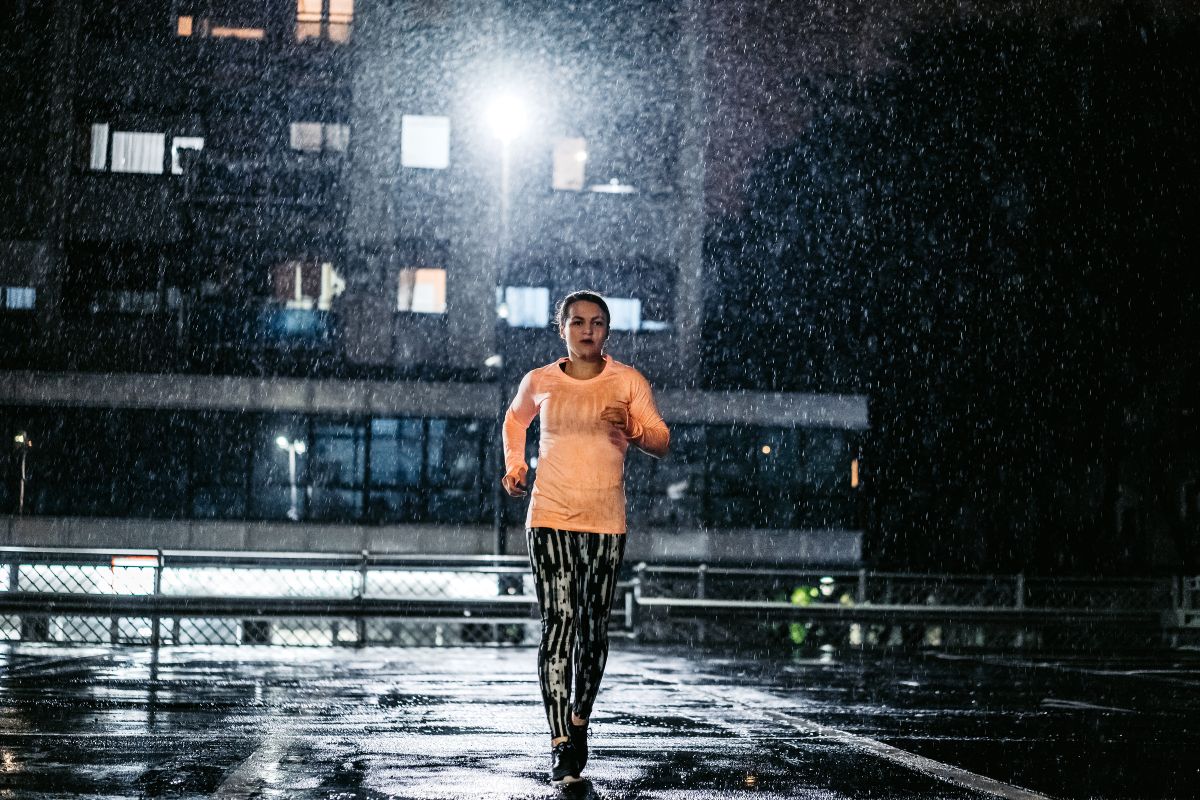Sometimes the forces of nature just aren’t on our side. But we as runners can’t let that stop us from doing what we love.

Come rain or shine we need to be prepared for every outcome.
Which is why we’ve created this guide on how to dress appropriately for any temperature.
Now you can focus on your performance rather than how hot or cold you are.
Below 40 Degrees Fahrenheit
It seems to be the winter weather that most runners find difficult to dress for.
Especially because the idea of running in winter coats and scarfs seems comical.
Rest assured that it’s not that outlandish, it’s all about one word: Layers!
Layers of technical running clothes to be exact.
From thermal to compression you need something that will keep you warm but will also allow you to sweat.
No matter how cold it is, if you’re raising your internal temperature by running you’re bound to produce sweat.
The first step is a decent base layer.
You want something that will allow you to layer on top of it, but can work by itself in case the weather rapidly changes.
Since it is the fabric that will be touching your skin you will need it to be breathable and moisture-wicking.
On top of the base layer you need a mid layer or layers. These should act as an insulator, you want to keep your body warmth in.
When deciding on these, take into account the weather not just the temperature, rain and wind can make it feel colder than it actually is.
Cover it all in a sturdy outer layer to block any wind, rain or snow. You want it to be a lightweight material so it doesn’t drag you down.
This layer is essential when the weather drops below freezing temperatures.
If your clothes do get wet during your run then take them off as soon as you get home and put warm clothes on, you don’t want to get hypothermia.
For those especially cold days we recommend gloves and a hat. You lose a lot of heat through your fingers and your ears can get notably cold.
You can get special gloves that will allow you to still use your touchscreen tracking devices.
Arguably the most important clothing to a runner is their shoes, and this stays true in the winter season.
If there is snow or ice outside then pick a pair with good grip, or invest in some snow spikes.
We also recommend waterproof ones since wet socks are not ideal.
Speaking of socks, make sure they’re breathable, wool socks may sound warm but they are terrible for perspiration.
While shoes are important year round there is one thing that is essential in winter, visibility.
With colder weather comes less daylight so you may be running in the dark.
Wear high-vis jackets, have lights on your hat, anything you need to do so cars and bikes are able to see you.
40 To 60 Degrees Fahrenheit

The seasons of fall and spring typically provide the best conditions for running, not too hot and not too cold. But that doesn’t mean you shouldn’t dress accordingly.
Like winter you will need layers for these transition seasons, but aim for lighter layers.
A long sleeve and tights base layer will be enough on most days with a shirt and shorts over it.
If the weather gets windy then a windbreaker will be your best friend. It can protect you from the elements without any weight.
The best part being if you don’t need it anymore you can fold it up to fit in your pocket or tie it around your waist.
The temperature around these seasons are less predictable so dress for it to be hotter than it is.
You will naturally heat up on your run and you can always take off layers if you need to.
Remember, around late fall and early spring you need to be aware of how visible you are to motorists.
Your safety should be your top priority.
Above 60 Degrees Fahrenheit
You may be tempted to just wear shorts or a sports bra for summer, and while that may be needed for temperatures about 90, it may not be the best choice for all sunny days.
The sun can be just as dangerous as cold weather which is why you need to protect your skin with thin layers.
Choose clothing that is breathable and sweat wicking since you will be sweating a lot.
Contrary to popular belief, white isn’t the best color for summer running.
You want dark or brightly colored clothing since it absorbs the UV rays rather than allow them to reach the skin.
In order to protect your face you will need a running hat, if you want extra protection for your eyes then a good pair of non-slip sunglasses won’t go amiss.
For any parts of your body not covered you will need to cover in sweat resistant sunscreen, especially if you’re going for less clothing on those extra hot days.
As a runner you always want to carry a water bottle on your person.
This is essential during hotter weather, dehydration can cause headaches and fatigue and should be avoided.
Conclusion
It’s important to remember that all this information is meant to be taken as a guide.
Some people will run hotter than others and so will need less clothing.
Find what’s best for you and don’t judge your fellow runners if their clothing choices are different to yours.
You may even be someone who would rather run on a treadmill than in the snow, or take a lazy day when it is too hot to function.
As long as you are prepared for the days between the extreme days then I will say this guide has done its job.
- Can Dogs Run Faster Than Humans? (Running With Your Furry Friend) - October 4, 2022
- 10 Doggie Fun Runs You Will Love [Ultimate Guide] - October 4, 2022
- What Are Division Results In Running? - October 4, 2022








